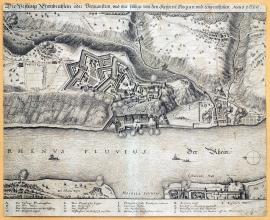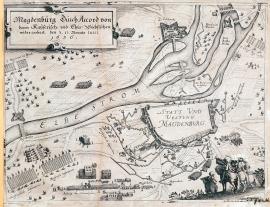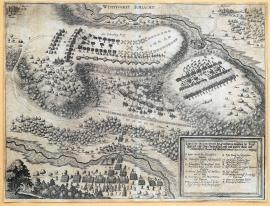Engravings of the year 1636

The fortress of Ehrenbreitstein i.e. Hermanstein, which was seized and conquered by the Imperial army. Year 1636.
The print depicts the territory around the confluence of the rivers Moselle and the Rhine with the town of Koblenz nearby. On a rather high hill on the other side of the Rhine is the Ehrenbreitstein fortress depicted accurately with the surrounding fortification constructions. There are deep-cut valleys, ravines and streams in the landscape. The German text is placed above the picture, while the caption A-R is below it.

Prague
This is a wide view of the city of Prague with the river Vltava spanned by a stone bridge flowing through its centre. A stylised ruin stands in the left foreground with the Strahov Monastery visible behind it. The Baroque-style cartouches drawn over the city show the coats-of-arms of Hradčany, Old and New Town and Malá Strana, the Imperial Eagle and the Czech Lion. The city quarters and important buildings are marked with names. There is a rectangular cartouche at the bottom centre with names of 20 remarkable buildings in Czech, Latin and German. The coat-of-arms of the author (Hollar) with an inscription:,Wenceslaus Hollar a Lewengrun et Bareyt hanc regni Bohemiae Metropolim, Patriam suam, ex monte Sct. Laurentii A. 1636 exactissime delineavit & aqua forti in hanc formaa aeri insculpsit, Antwerpae A. 1649.‘ is at the top. Translation: ‚Václav Hollar of Lewengrun and Bareyt painted as accurately as possible this capital city of the Bohemian Kingdom, its homeland, in the year 1636, from the hill of St. Lawrence (present day Petřín) and using the aqua fortis (the nitric acid used for etching) he etched this view into a copperplate in Antwerp, year 1649.

Magdeburg was conquered again by the Imperial and Saxon /regiments/ and handed over upon agreement on 13 July 1636.
The engraving depicts the river Elbe streaming out into several branches. The city of Magdeburg lies above the river. The author did not outline the centre of the city, there is only the inscription ‚Magdeburg‘. The Imperial-Saxon army fighting formations are lined-up outside the city while a relatively small Swedish garrison is leaving it from the other side. There are four mounted buglers at the bottom right. The above-stated German text is placed in an ornamental vignette in the top left corner.

An original outline of the fight of the Imperial, Catholic and Saxon army with the Swedish near Wittstock on 24 September 1636.
There is an inscription below the bottom border of the engraving:,Wittstocker Schlacht’. A small river is flowing on the right with the small town of Wittstock above it. There are two hilltops in the depicted landscape with the armies fighting atop. The fights are also depicted in the valley spreading out towards the river. The caption A-P and the above-stated text are placed below the picture part of the print.


